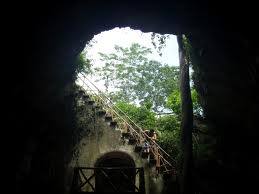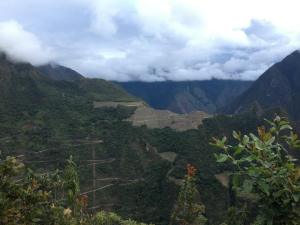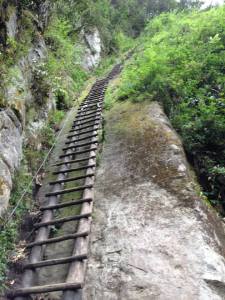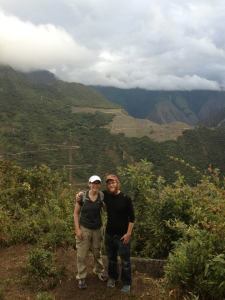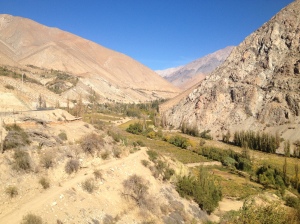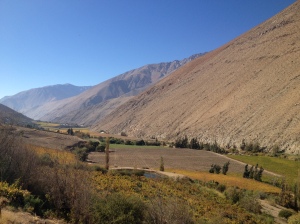This slideshow requires JavaScript.
Lazy but craving adventure, I opted for the 1000 feet long railway bridge that was missing half its planks.
Charles Darwin was not impressed with his trek to the highest peak in the Western Hemisphere. “The scenery thus far was very uninteresting,” he wrote of the behemoth’s outlet valley. He was so unimpressed, that he didn’t bother to mention Mount Aconcagua in the Voyage of the Beagle, leaving his description for an appendix.
Given the “scene of desolation” as Darwin called it, was there really much to experience in the Uspallata Pass that connects Santiago, Chile, and Mendoza, Argentina? More than anything else, the two days I spent exploring the area taught me that, sometimes you have to create your own adventure.
…
Not being a mountaineer, I was wondering just exactly why I should visit Aconcagua. Eventually, my nostalgia for Mount Denali propelled me to its base. Having spent a week in Alaska for a friend’s wedding, I extended my trip by four days to hike in the mountain’s namesake park. The experience of creeping around a mountain pass on a gravel road in a rickety old bus, and suddenly finding America’s largest mountain radiating in sunlight, stunned me. I was hoping to recreate that experience in South America, but I soon learned it would be impossible.
The Uspallata Pass is one of the busiest routes between Chile and Argentina, connecting the Pacific nation’s capital with Argentina’s wine center. A two lane road rises out of the Mendoza desert, ascending canyon walls for 215 kilometers to the 12,500 feet Chilean border. The route contains some of the most popular attractions in the country including Argentina’s biggest ski resort, the Mountain of Seven Colors, a natural bridge, and the aforementioned Mt. Aconcagua.
The Mountain of Seven Colors lies a barren 10 miles to the east of the town of Usapallata along a hint of a dirt road. To make viewing it an adventure, I decided to bike the route and climb on top. And to attain the necessary level of risk, I had allowed my travel insurance to expire the day before. Though the ride was just ten miles, the terrain required an ascent of 2000 dusty feet. After ten or fifteen dirt bikes and dune buggies cruised around me, I finally made it to the mountain’s tiny parking lot. Though its characterization as a “mountain” proved misleading, the setting sun behind me lit up the rock formation’s glittery layers of greens and reds. And the perfectly level top, without easy access, attracted my climbing legs.
Locking the bike, I ran up the gravel slopes, looking for a place to climb on top. At 10,000 feet, I was promptly exhausted. Eventually I found a place where, if I left my backpack behind, I could scramble atop the alien landing site. The views to the Chilean border, with Aconcagua showing its snowy tip behind a short range of closer peaks, rewarded my self-inflicted adventure.
The next day I hopped on a bus to view the ancient bridge and climbing mecca. By this time, I knew Aconcagua wouldn’t deliver like Denali, but I was still hopeful. The reason Denali lights up the senses is that it’s the only mountain in sight. The peak’s giant base stretches for miles. Standing at 3,000 feet, looking up at a 20,000 feet mountain, you contemplate existence.
In contrast, to reach Aconcagua, the road itself passes by at 8,000 feet, and the giant’s surrounding mountains nearly reach its shoulders. Instead of four hours on a narrow gravel road, an hour long stroll through the nearly deserted valley delivers you at its feet. By the time I had reached the park’s limit, I had barely broken a sweat. To turn this leisurely outing into an adventure, I ran ahead of the other bus tourists and climbed the 45 degree canyon wall of loose shale to find a perch suitable for consuming my lunch. Hanging 50 feet above the valley, with the mountain to myself, my peanut butter sandwich almost made me reminiscent of Alaska.
But the adventurer in me was hardly satiated. Five kilometers downhill from Aconcagua sat Puente del Inca, my last potential adventure. Though it sounds exciting, it becomes less so after learning the British built a VIP bathhouse nearby and paved over the bridge with asphalt. Darwin was disappointed too, writing, “The Bridge of the Incas is by no means worthy of the great monarchs whose name it bears.”
With several hours to spare, and not much adventure too look forward to, I hiked down the narrow valley between the mountain and the monarchs. Just before the landmark came into view, I was left with three choices to cross the same stream over which nature had already laid itself. The international roadway crossed a modern bridge and carried a sidewalk. Next to it lay a decades old railroad bridge with a leaky pipe running across it. And hundreds of feet below, lay the ancient roadway that Darwin himself probably used to cross the stream. Lazy but craving adventure, I opted for the 1000 feet long railway bridge that was missing half its planks.
Luckily, some industrious resident of Puente del Inca had installed a handrail across the bridge, making it easier to repair the pipe. For the first two thirds of the bridge, which was about fifteen feet wide and sturdy against the wind, someone had laid wooden 2 x 12s atop the underlying trestle. Holding on to the railing, I slowly tiptoed across the boards which, though new, remained unfastened. Halfway through my tightrope, I looked back as apprehension started to build in my chest. After another 100 feet, I remembered once again that my travel insurance had expired. Then another 100 feet, “Isn’t it Mother’s Day?” Finally, with the last section in site, I came to a gap in the bridge. My reliable wooden platform had run out, and I was reduced to crawling across the steel rails and their supports with three feet of air between each one, stretched above the stream hundreds of feet below.
Though terrified, I smiled to myself, realizing I had finally found an adventure befitting the tallest peak in the Americas. Stunned for a few seconds, I took a deep breath, and slowly stepped across the last open air between me and my destination. Once I returned to the wooden supports , I ran off the bridge gasping for air.
Though interested in the natural bridge, I found myself agreeing with Darwin, let down by the monument. After analyzing it from every angle, I found a comfortable café in which to spend my final hour before my bus arrived.
Standing in the windy parking lot, with the sun setting and the cold settling in, I was looking forward to heading down the mountain to my warm hostel and an Argentine steak. Darwin, too, knew this is what really made travelers satisfied after seeing the valley:
“The extreme pleasure, I suspect, is chiefly owing to the prospect of a good fire and of a good supper, after escaping from the cold regions above: and I am sure I most heartily participated in these feelings.” On nearly every aspect of this region, Darwin and I agreed.




